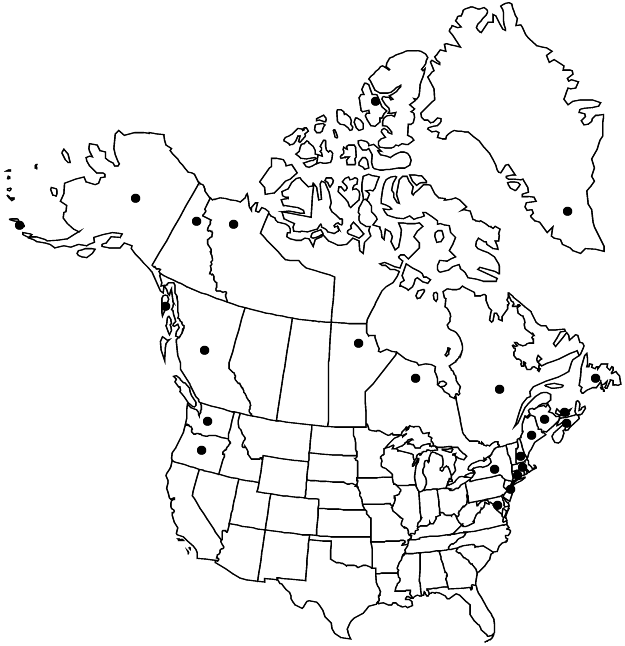Difference between revisions of "Honckenya peploides"
Neues Mag. Aerzte 5: 206. 1783.
FNA>Volume Importer |
RevisionBot (talk | contribs) m (Bot: Adding category Revised Since Print) |
||
| (5 intermediate revisions by 3 users not shown) | |||
| Line 6: | Line 6: | ||
|place=5: 206. 1783 | |place=5: 206. 1783 | ||
|year=1783 | |year=1783 | ||
| + | }} | ||
| + | |special_status={{Treatment/ID/Special_status | ||
| + | |code=F | ||
| + | |label=Illustrated | ||
}} | }} | ||
|basionyms={{Treatment/ID/Basionym | |basionyms={{Treatment/ID/Basionym | ||
|name=Arenaria peploides | |name=Arenaria peploides | ||
|authority=Linnaeus | |authority=Linnaeus | ||
| + | |rank=species | ||
|publication_title=Sp. Pl. | |publication_title=Sp. Pl. | ||
|publication_place=1: 423. 1753 | |publication_place=1: 423. 1753 | ||
| Line 24: | Line 29: | ||
-->{{Treatment/Body | -->{{Treatment/Body | ||
| − | |distribution=Coastal North America;Eurasia. | + | |distribution=B.C.;Man.;N.B.;N.S.;N.W.T.;Nfld. and Labr. (Nfld.);Nunavut;Ont.;P.E.I.;Que.;Yukon;Alaska;Conn.;Maine;Mass.;Md.;N.H.;N.J.;N.Y.;Oreg.;Wash.;Coastal North America;Eurasia. |
|discussion=<p>Subspecies 4 (3 in the flora).</p><!-- | |discussion=<p>Subspecies 4 (3 in the flora).</p><!-- | ||
--><p><i>Honckenya peploides</i> is polymorphic. A number of species and infraspecific taxa have been described from various parts of its geographical range. Recently, four subspecies of <i>H. peploides</i> have been recognized (A. Kurtto 2001b; V. V. Petrovsky 1971, 2000), as here; subsp. peploides occurs along European coasts. <i>Honckenya</i> is subdioecious (Petrovsky 1971, 2000; T. Tsukui and T. Sugawara 1992), and is pollinated largely by small bees, hover-flies, flies, and ants (Tsukui and Sugawara). The report of <i>Honckenya</i> (as Ammodenia) in Chile is an error based on G. Macloskie (1903–1914, vol. 1) (C. Marticorena, pers. comm.).</p> | --><p><i>Honckenya peploides</i> is polymorphic. A number of species and infraspecific taxa have been described from various parts of its geographical range. Recently, four subspecies of <i>H. peploides</i> have been recognized (A. Kurtto 2001b; V. V. Petrovsky 1971, 2000), as here; subsp. peploides occurs along European coasts. <i>Honckenya</i> is subdioecious (Petrovsky 1971, 2000; T. Tsukui and T. Sugawara 1992), and is pollinated largely by small bees, hover-flies, flies, and ants (Tsukui and Sugawara). The report of <i>Honckenya</i> (as Ammodenia) in Chile is an error based on G. Macloskie (1903–1914, vol. 1) (C. Marticorena, pers. comm.).</p> | ||
| Line 57: | Line 62: | ||
-->{{#Taxon: | -->{{#Taxon: | ||
name=Honckenya peploides | name=Honckenya peploides | ||
| − | |||
|authority=(Linnaeus) Ehrhart | |authority=(Linnaeus) Ehrhart | ||
|rank=species | |rank=species | ||
| Line 64: | Line 68: | ||
|basionyms=Arenaria peploides | |basionyms=Arenaria peploides | ||
|family=Caryophyllaceae | |family=Caryophyllaceae | ||
| − | |distribution=Coastal North America;Eurasia. | + | |distribution=B.C.;Man.;N.B.;N.S.;N.W.T.;Nfld. and Labr. (Nfld.);Nunavut;Ont.;P.E.I.;Que.;Yukon;Alaska;Conn.;Maine;Mass.;Md.;N.H.;N.J.;N.Y.;Oreg.;Wash.;Coastal North America;Eurasia. |
|reference=None | |reference=None | ||
|publication title=Neues Mag. Aerzte | |publication title=Neues Mag. Aerzte | ||
|publication year=1783 | |publication year=1783 | ||
| − | |special status= | + | |special status=Illustrated |
| − | |source xml=https:// | + | |source xml=https://bitbucket.org/aafc-mbb/fna-data-curation/src/2e0870ddd59836b60bcf96646a41e87ea5a5943a/coarse_grained_fna_xml/V5/V5_283.xml |
|subfamily=Caryophyllaceae subfam. Alsinoideae | |subfamily=Caryophyllaceae subfam. Alsinoideae | ||
|genus=Honckenya | |genus=Honckenya | ||
| Line 75: | Line 79: | ||
}}<!-- | }}<!-- | ||
| − | -->[[Category:Treatment]][[Category:Honckenya]] | + | --> |
| + | |||
| + | [[Category:Treatment]] | ||
| + | [[Category:Honckenya]] | ||
| + | [[Category:Revised Since Print]] | ||
Latest revision as of 17:06, 6 November 2020
Plants maritime, glabrous; rhizomes spreading. Stems simple or branched, 5–25(–50) cm. Leaf blades usually long-elliptic to ovate, sometimes lanceolate to oblanceolate, obovate, or broadly elliptic, 4–46 × 0.5–20 mm, succulent, margins often crenulate, apex acute to acuminate or apiculate. Pedicels 2–10(–26) mm. Flowers strongly honey-scented; sepals ovate, 3.5–7 mm; petals spatulate to narrowly oblanceolate, abruptly constricted toward base, 2.5–6 mm in staminate flowers, 0.8–2 mm in pistillate flowers; filaments 2.5–5 mm in staminate flowers; anthers 0.5–0.7 mm, 0.5–0.8 mm in pistillate flowers. Capsules ovoid to subglobose, 5–10 × (4.5–)5–12 mm, fleshy or chartaceous. Seeds 2–4 mm, rugulose. 2n = 66, 68, 70.
Distribution

B.C., Man., N.B., N.S., N.W.T., Nfld. and Labr. (Nfld.), Nunavut, Ont., P.E.I., Que., Yukon, Alaska, Conn., Maine, Mass., Md., N.H., N.J., N.Y., Oreg., Wash., Coastal North America, Eurasia.
Discussion
Subspecies 4 (3 in the flora).
Honckenya peploides is polymorphic. A number of species and infraspecific taxa have been described from various parts of its geographical range. Recently, four subspecies of H. peploides have been recognized (A. Kurtto 2001b; V. V. Petrovsky 1971, 2000), as here; subsp. peploides occurs along European coasts. Honckenya is subdioecious (Petrovsky 1971, 2000; T. Tsukui and T. Sugawara 1992), and is pollinated largely by small bees, hover-flies, flies, and ants (Tsukui and Sugawara). The report of Honckenya (as Ammodenia) in Chile is an error based on G. Macloskie (1903–1914, vol. 1) (C. Marticorena, pers. comm.).
Selected References
None.
Lower Taxa
Key
| 1 | Plants stout; stems 3-6 mm diam., ascending to weakly erect; pedicels 2-3 mm | Honckenya peploides subsp. robusta |
| 1 | Plants slender; stems 0.5-3 mm diam., prostrate to decumbent; pedicels 3-26 mm | > 2 |
| 2 | Stems 10-30(-50) cm × 1-3 mm, few; internodes of main stem 8-40(-60) mm; main stem leaves widely spaced, conspicuously larger than those of lateral branches, blade elliptic-obovate to broadly elliptic or narrowly elliptic or oblanceolate, (10-)20-46 × (0.5-)10-20 mm; pedicels (3-)8-16(-26) mm | Honckenya peploides subsp. major |
| 2 | Stems 5-15(-21) cm × 0.5-2.5 mm, numerous; internodes of main stem 5-30 mm; main stem leaves evenly spaced, similar in size to those of lateral branches, blade elliptic or ovate to obovate, 4-20(-30) × 3-9(-18) mm; pedicels 3-10(-15) mm | Honckenya peploides subsp. diffusa |